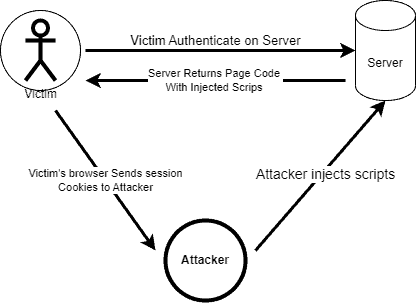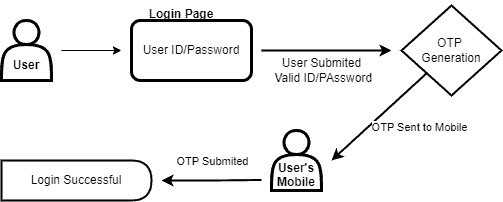1. Introduction
In this tutorial, we’ll discuss session hijacking and investigate the underlying weaknesses that enable these attacks. We’ll provide helpful tips and share best practices to protect applications from this threat.
2. Session Hijacking
Session hijacking is a security threat where an unauthorized person gains control over a legitimate user’s session on a computer network.
The server automatically generates sessions for every user and assigns each session a unique session ID. In a session hijacking, the attacker intercepts the ID and exploits it to gain unauthorized access to the active session:

This attack compromises application security by exploiting the trust between a user and an application during a session.
3. Risk Factors and Vulnerabilities
The risk is that hijackers may steal sensitive information. This includes personal information, financial details, confidential business data, or any other information accessible during the session. The attackers can use the information for various malicious purposes, including identity theft or financial fraud.
Session hijacking attacks erode user trust in the affected web application or service. Users may lose confidence in the security measures implemented by the app owner, leading to a decline in usage, customer churn, or negative word-of-mouth.
Mitigating these risks requires organizations to implement strong security measures.
4. Best Practices for Preventing Session Hijacking
There are several ways to prevent session hijacking.
4.1. Strong Session Management
It’s essential to ensure that session IDs are long, random, and complex enough to resist guessing or brute-force attacks. Ideally, we’ll use a cryptographically secure method to generate a session ID.
Setting an appropriate session expiration time limits the duration of active sessions. When a session expires, re-authentication is required to establish a new one.
Regenerating session IDs upon significant events, such as successful authentication or before accessing sensitive information, is also a recommended prevention practice.
Validating the IP address of incoming requests against the IP address associated with the session allows for detecting abrupt changes. We can terminate the session or require additional authentication in such cases.
4.2. Cross-Site Scripting (XSS) Prevention
Attackers commonly exploit the cross-site scripting (XSS) vulnerability to insert malicious scripts into web pages, which can be a launching point for session hijacking attacks. By injecting malicious JavaScript into a victim’s browser, an attacker can extract the victim’s session cookies and gain control over their session. The following tips can help prevent XSS vulnerabilities.
The client and server sides should implement strict input validation to filter out potentially malicious characters and scripts. Additionally, when rendering user-generated content, it is important to use output encoding techniques like HTML entity encoding or context-specific encoding to prevent script execution.
A content security policy helps restrict the types of content loaded and executed on a web page. This mitigation technique involves safe listing trusted sources for scripts, stylesheets, and other resources to prevent the execution of injected scripts.
Setting the HTTP-only flag on session cookies can prevent client-side scripts from accessing or modifying them, making it more challenging for attackers to steal session cookies through XSS vulnerabilities.
4.3. Token-Based Authentication
Token-based authentication generates and sends a unique token to the client upon successful login, replacing the traditional session-based authentication method and avoiding the need for the server to store user credentials. This token is commonly in the form of a JSON Web Token (JWT)
Tokens should have short lifetimes and expire after a certain period of inactivity. When a token expires, the user has to re-authenticate to get a new token. This approach reduces the opportunity for attackers to hijack an active session.
When the server receives a token from a client, it must validate the token’s authenticity and integrity. This validation process includes verifying the token’s signature and checking its expiration, issuer, and other relevant information. By following these and similar steps, we can identify unauthorized tokens.
4.4. Regular Session Monitoring and Auditing
It’s important to enable comprehensive logging of session-related activities, including successful and failed login attempts, creation, destruction, and significant session events. Logs should capture relevant information such as user IDs, IP addresses, timestamps, and actions performed to ensure effective session monitoring and auditing.
We should monitor sessions in real-time to check for anomalies. This includes implementing intrusion detection or prevention systems (IDS/IPS) that analyze network traffic and flag suspicious behavior and using security information and event management (SIEM) solutions that provide centralized log analysis and have alert capabilities.
We should leverage user behavior analytics (UBA) to establish baseline behavioral patterns for individual users and detect deviations that may indicate session-hijacking attempts.
5. Additional Security Measures
By implementing these additional security measures, the defense against session hijacking can be significantly strengthened, thereby enhancing the overall security of our applications.
5.1. Implementing IP Filtering and Session Timeouts
A maintained and up-to-date safelist of trusted IP addresses or IP address ranges can be established to control access to the application or session. Additionally, a firewall or another filtering system should be installed to actively deny requests from IP addresses outside the safelist:

An appropriate session timeout period should be defined based on the application’s requirements. This period should strike a balance between security and usability considerations. Enforcing the session timeout settings on both the client and server sides is necessary. Providing users with warnings or notifications before their sessions are about to expire is also recommended.
We should consider implementing a ‘remember me’ feature that offers a separate, longer-lived session for user convenience. However, it’s crucial to ensure that this feature is secure.
5.2. Implementing Two-Factor Authentication
Two-factor authentication is a security feature implemented during session login to provide an additional layer of security. Users are required to provide two separate forms of credentials, or authentication factors, to verify and prove their identities before accessing an application or session:

Typically, the first factor in two-factor authentication is something the user knows, such as a password or PIN. The user possesses the second factor, including a physical token, a mobile device, or a biometric trait like a fingerprint.
6. Conclusion
In this article, we talked about session hijacking.
Preventing session hijacking requires a multifaceted strategy. Organizations can effectively reduce the risk of session hijacking by implementing the solutions we discussed.